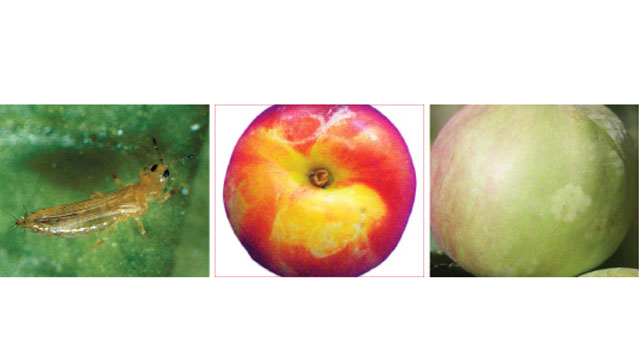Western flower thrips (WFT) are a pest of all the main temperate tree fruit crops. They are known to be particularly damaging to nectarines.
Pest identification
Adult western flower thrips (WFT) are pale brown–yellow, with narrow bodies and are about 1–2 mm long (Figure 1).
WFT are hard to identify in the field and inspection under a light microscope will usually be required to differentiate them from other pest species such as plague thrips and onion thrips.
To properly identify the pest thrips in your orchard, consider trapping and sending samples of the thrips to an accredited laboratory.
Damage
WFT damages the skin of certain temperate fruits including apples and nectarines by feeding on the fruit surface.
As the damaged skin cells grow, the injury develops into a russet (Figure 2), or in apples, the fruit develops an unusual pansy flower-shaped spot (Figure 3).
Monitoring
Monitor for thrips species using yellow sticky traps hung throughout the orchard from bud burst to harvest. The traps will give you an indication of thrips activity and can also be sent to a laboratory to obtain a formal identification of the pest species.
Management
Cultural and physical
Controlling established WFT populations will require timely pesticide application.
However, several management practices will reduce pest numbers and minimise damage. As broadleaf weeds (particularly clover) are an alternative host for WFT, keep ground covers mown short throughout the year to prevent flowering, but do not mow when fruit trees are in blossom.
Choose pesticides that are less harmful to beneficial insects to encourage their presence and survival.
Where practical, thin fruit to singles or aim to keep clusters open as this will make the environment around the fruit less attractive to thrips.
Biological
There are several natural predators of thrips including predatory mites, bugs, lacewings, predatory thrips, lady beetles and parasitic wasps.
However, these are unlikely to provide full control of WFT.
Chemical
Registered or permitted chemical options for the control of WFT are limited and differ from those used to manage plague thrips, therefore correctly identifying the pest thrips species is vital.
Download the Orchard plant protection guide
See this article in Tree Fruit Dec 2022




















